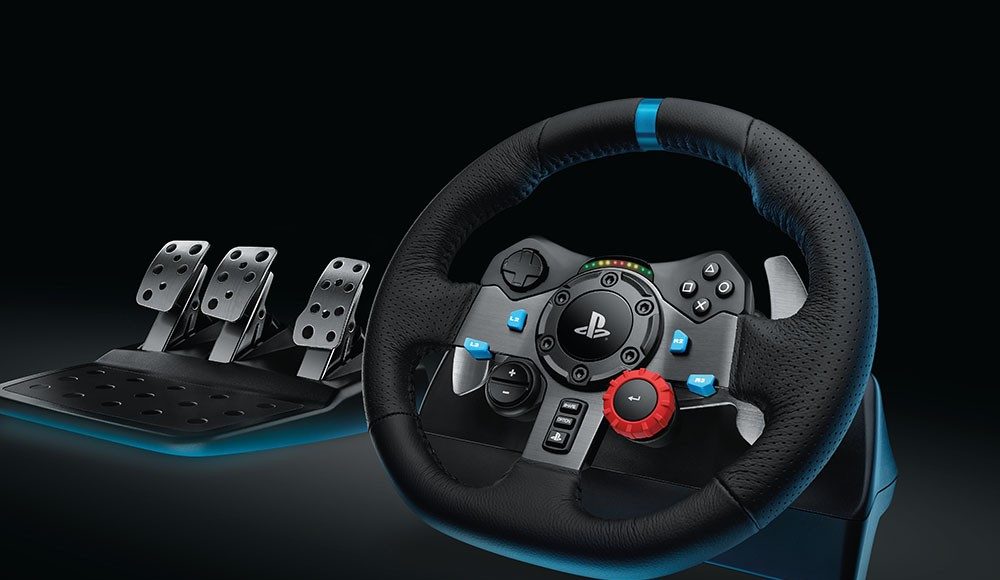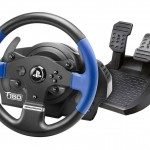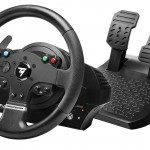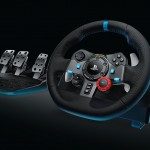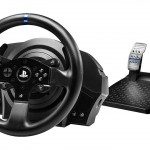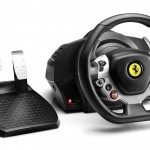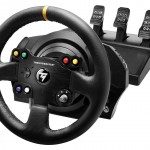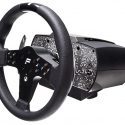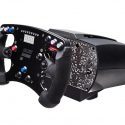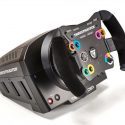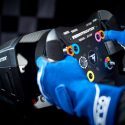The Details
Want to know more? Here’s the extended breakdown of our recommendations.
Thrustmaster T150/TMX (~$170)
A few years ago, the most commonly-recommended entry-level set was the Logitech Driving Force GT. Often sold at half the price of the flagship G27, it offered the same degrees of steering rotation, but with cheaper materials and weaker force feedback. The two-pedal set was a very basic, plastic affair, with almost no resistance, but reliable enough for many hours of fun. The DFGT is discontinued, but still well-supported across PC sims, so a second-hand unit is probably the cheapest way to give sim racing a try.
When the Thrustmaster T150 was introduced in 2015, it became recognised as ‘the new Driving Force GT’—the obvious choice for an entry-level wheel and pedal set. Technology has improved, but it shares many similarities with the old Logitech unit: a weaker force-feedback system than the models higher in the range, and a basic, plastic two-pedal set with very little resistance. Sitting at the bottom of the ‘T-Series’ ecosystem, the T150 (and Xbox One-compatible TMX variant) becomes a more compelling proposition when combined with the optional T3PA pedals (~$150) and TH8A shifter (~$170).
In January 2017, Thrustmaster introduced the T150 Pro/TMX Pro bundle, which combines the wheel and T3PA pedals for $250.
Much praise has been aimed at the hybrid belt and gear steering mechanism, but make no mistake, this is not a high-performance device. The heavy mechanical resistance dilutes the feedback output, and it lacks precision, but it feels solid enough in the hands at this price. Unlike the higher spec wheels in the range, the T150/TMX has a fixed rim which means sadly the wheel rim add-ons aren’t compatible.
Logitech G29/G920 (~$300)
In 2007, the Logitech G25 launched to wide acclaim, offering a leather wheel, heavy-duty three-pedal set, and a gear shifter in a single package. The G27 arrived a few years later sporting various refinements, and remains a very capable product, still a popular wheel amongst sim racers. Its biggest upgrade was the helical gear system, which provided much smoother steering (eliminating the ‘notches’ of a typical gear drive).
The Logitech G29 is the latest, PS4-compatible iteration, retaining the helical gearing, and uses improved sensors for more steering precision. The Xbox One-compatible G920 variant has fewer buttons, so for a PC-centric setup, the G29 is the one to pick. Logitech have opted to remove the H-shifter from the package, but it is available separately. The pedals have always been the strongest point of Logitech’s G wheels, and the G29/G920 set is no exception, using a predominantly metal construction and now sporting a progressive, higher-resistance brake pedal.
The G29/G920 received heavy criticism at launch for its high price and lacklustre design evolution over the G27, but prices have dropped and Logitech is still offering a high quality product here; a noticeable step above a T150/TMX in both performance and materials. And being the most mainstream brand that produces driving controllers, the models are widely available and sometimes heavily discounted.
Thrustmaster T300/TX (~$300)
The Thrustmaster T300 and TX bases represent an interesting alternative to Logitech’s G29 and G920, but this is where it starts to get complicated. Due to the wide range of T-Series add-ons, the T300 and TX currently sell in multiple packages and bundles, with some confusing naming conventions.
The basic T300RS package includes a rubber-finished wheel that is a little on the heavy side, and a rather disappointing two-pedal set. It’s a step above the T150 pedal unit, but not by much. The equivalent TX package is the TX Italia, an officially-licensed Ferrari product. The rim is a 7/10 scale replica of a 458 Italia wheel, with a mostly plastic construction, making it much lighter than the stock T300RS rim. As they use the same motor, this results in more responsive force feedback, but the materials feel cheap, very similar to the T150/TMX rim. The TX Italia pedals are similarly disappointing. In a nutshell, the basic T300RS and TX Italia packages fall short of what Logitech provide with the G29 and G290 which feature leather wheels and a substantially better three-pedal set.
Where the T300 and TX shine however, is in the wheel base construction. Using a belt-driven steering mechanism combined with a brushless motor, it delivers smooth steering and convincing, detailed force feedback. This mechanism is unquestionably a step above Logitech’s design, feeling more like a real steering rack in all situations. And here, the T-Series ecosystem is fully compatible, meaning Alcantara or Leather wheels can replace the unremarkable stock rims, and the T3PA or even T3PA-PRO pedal sets can be used along with the TH8A shifter, taking the ultimate package well beyond the spec (and price) of the G29.
Thrustmaster T300 Alcantara Edition / TX Leather Edition Bundles (~$470)
Thrustmaster have embraced a modular approach, selling the T300 and TX as standalone bases without rims or pedals. But they also offer two higher-end bundles of the most popular combinations: the T300 Alcantara Edition (T300 base, Alcantara rim, T3PA pedals) and the TX Leather Edition (TX base, leather rim, T3PA pedals).
As above, unless you need Xbox One compatibility, the T300 Alcantara Edition is probably the better option. Not only does it have 1080 degrees of rotation compared to the TX Leather Edition’s 900, but the bundled Alcantara rim is a more realistic 30cm diameter, and is one of the most comfortable on the market. Now that the T300 and TX bases can be found in several different packages, it’s worth shopping around, but these bundles represent good value compared to buying the add-ons at list price.
Fanatec CSL Elite range (~$500 and up)
Before concentrating their efforts on the high-end ClubSport range in 2011, Fanatec were competing in a lower price bracket alongside brands like Saitek, Logitech, and Thrustmaster with a selection of Porsche-branded hardware, long since discontinued. In recent years, the German manufacturer only offered the ClubSport Wheel base alongside its ClubSport pedals and a selection of rims and accessories—enthusiast-grade units with a combined price of over $1,000. In August 2016, Fanatec revealed a more affordable collection of devices, consisting of the CSL Elite wheel base and CSL Elite pedals, adding to the CSL P1 wheel rim that was introduced in 2015.
Today, there are two distinct tiers of Fanatec products, with the CSW V2.5 and V3/V3i ClubSport pedals remaining in the $1,000+ range and the CSL Elite bundle offered at around $500.
The CSL Elite wheel base is another jump up the ‘steering realism’ scale, delivering much more convincing feedback than the T300/TX. It shares some of the characteristics of Fanatec’s flagship CSW base, using less expensive components and materials to reduce the price by about $200. Its greatest asset is smoothness; Fanatec’s belt drive mechanism is far smoother than any wheel offered by Thrustmaster, including the new TS-PC. But unlike the CSW, which combines smoothness with detailed feedback, the CSL can feel somewhat ‘floaty’ at times, lacking some precision and detail.
With around 6Nm of torque available from the motor, the CSL is strong enough to give your arms a bit of a workout, but is not as beefy as the CSW V2 or V2.5. It benefits from using the CSL P1 rim, which, at 1178g, is the lightest of the Fanatec rims (a lighter rim means less work for the motor and a more direct feeling through the hands). While the base uses the same quick-release metal shaft as the CSW, some of Fanatec’s higher quality rims are considerably heavier, and less suitable for the CSL. In VR, the rim quality is somewhat less of a priority, as you won’t be looking at it; the P1 rim happens to be a great all-rounder. A great option for a different tactile sensation is the Fanatec Formula Black, ideal for single seaters and other modern race cars.
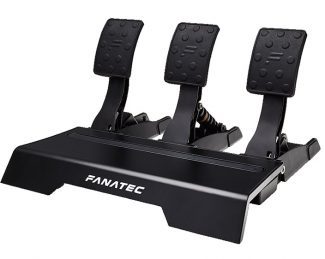
The basic CSL Elite pedal set only includes a throttle and brake, with the optional load cell kit adding a clutch pedal and a more realistic brake sensor, which is highly recommended, whether you intend to use a clutch or not. Pedal sets in the low to mid-range consumer segment use potentiometers to measure travel along each input axis, including the brake pedal. Some sets add a rubber bushing to reduce travel and increase resistance, but it is still being measured by the same sensor. A load cell replaces the potentiometer, measuring force rather than movement, so the driver learns to feel the correct amount of braking pressure required rather than trying to find a position along an axis. Braking ‘feel’ is arguably the most important part of sim racing, and the CSL Elite pedals LC is the most affordable load cell solution and can be used as a standalone USB device (on PC) with any of the steering wheels for VR listed here.
Thrustmaster TS-PC Racer (~$500 + pedals)
Launched in December 2016 as a PC-only flagship wheel, the TS-PC Racer is Thrustmaster’s latest evolution of the highly successful T-Series, effectively replacing the aging T500RS. While the newer, cheaper T300/TX became more popular in recent years, the T500RS hung on to its flagship status, with a tank-like build and more powerful motor. But the combination of a heavy belt mechanism and a brushed motor meant excessive mechanical resistance, resulting in feedback that couldn’t deliver the subtle details found on the T300/TX.
The TS-PC is the best of both worlds. Not only is it stronger than the T500RS (and also slightly more powerful than the Fanatec CSL Elite), it manages to deliver the small details in a more direct manner than the T300/TX. It feels essentially like a much more serious T300/TX, and easily the best wheel base Thrustmaster has made to date.
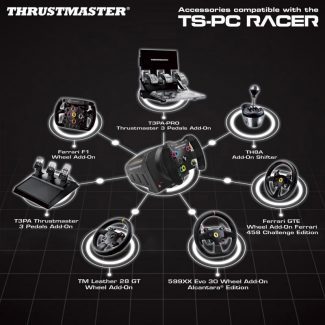
The included rim is a typical ‘formula’ design, with comfortable suede grips, positive paddle shifters and plenty of buttons. It doesn’t match Fanatec’s Formula Black quality, but has the benefit of weighing just 914g (about 300g lighter than the Fanatec), which further enhances the TS-PC’s performance. While ideal for many modern race cars (such as the F1 or GT3 series), it’s not an all-purpose rim, and you’ll probably want to consider a round wheel too, and the TS-PC is compatible with all of the T-Series options, including the excellent Alcantara rim.
You’ll also need to factor in a set of pedals, as none are included. A T3PA set would work, but at this level you might consider the all-metal T3PA-PRO, which are more suited to a load cell conversion. However, being PC-only, you can choose any standalone pedals, so the Fanatec CSL Elite pedals LC is the obvious choice.
The CSL Elite and TS-PC Racer are seen as direct rivals, despite some distinct differences. The Fanatec is much smoother and quieter, compared to the Thrustmaster’s notchy mechanism. But the TS-PC seems to resolve more subtle feedback detail, feels more direct, and is slightly stronger overall. If console gaming is a factor, then the CSL Elite bundle is a great option, being compatible with Xbox One and PC (a PS4-compatible CSL Elite variant is coming soon). But for PC-only use, a TS-PC combined with CSL Elite pedals has a performance edge over the full CSL Elite combination. However, the list price for the TS-PC is dangerously close to the price of the CSW V2.5 wheelbase, which is yet another step up.

